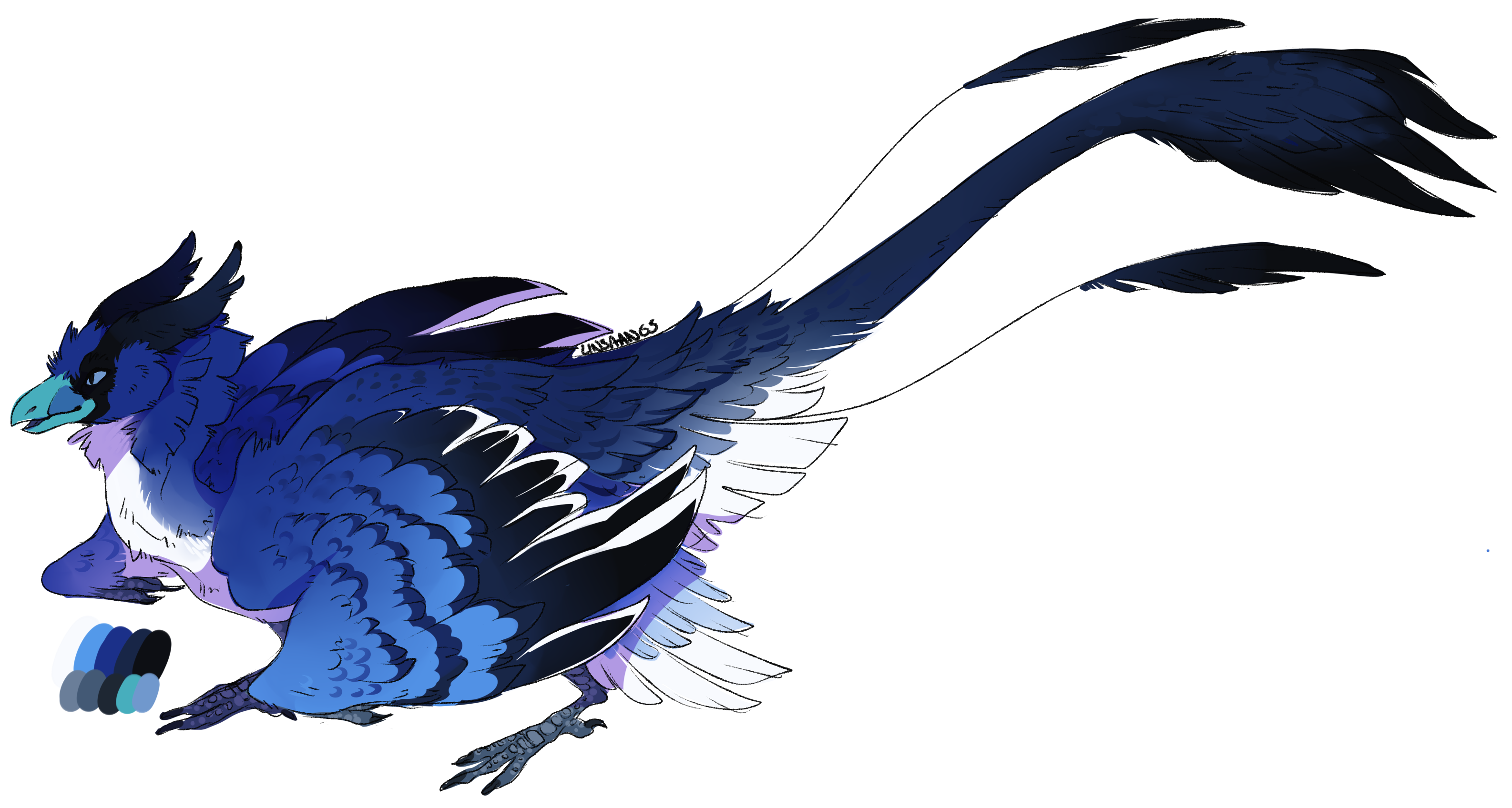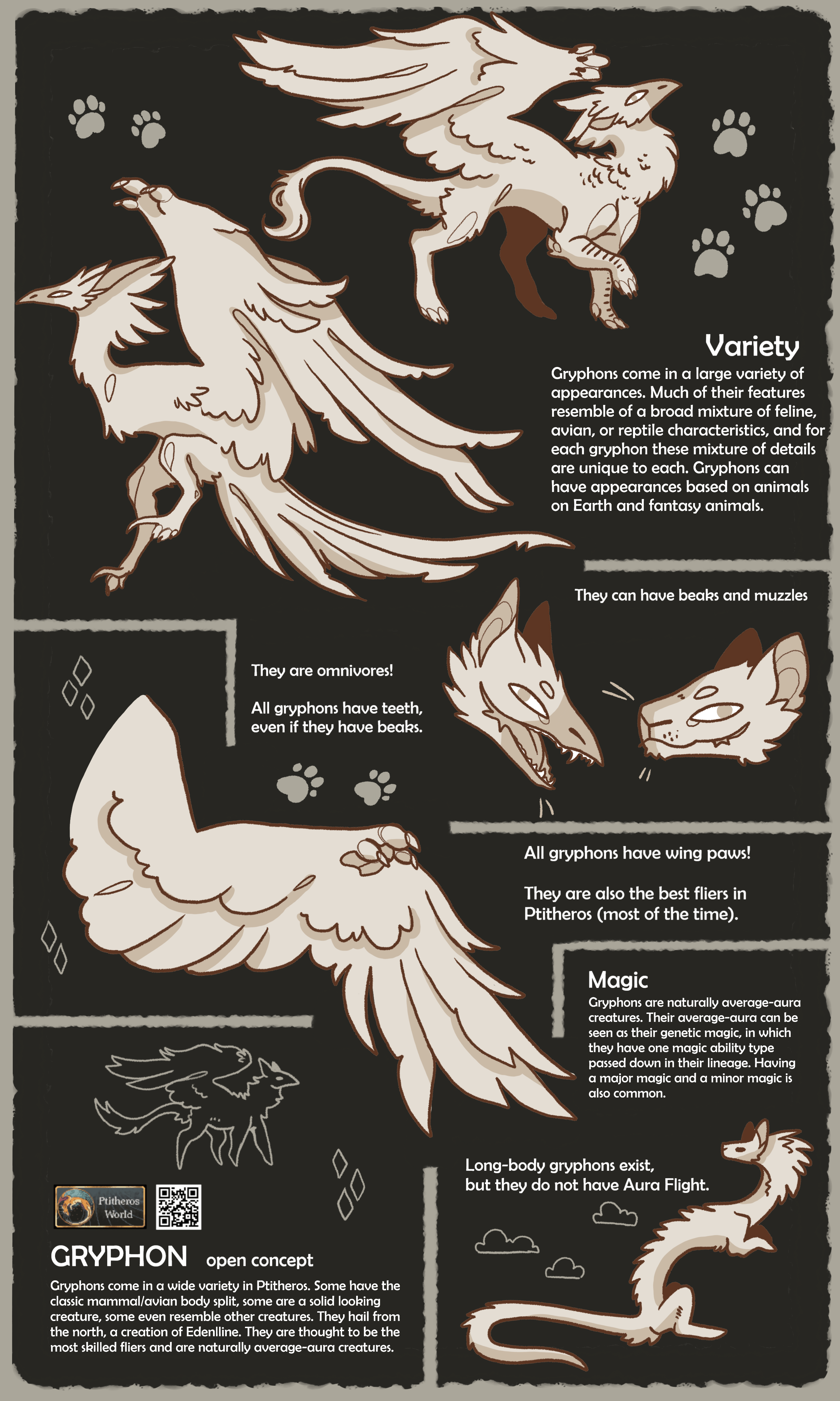

Gryphon
avantius felis drayceaus | open design
Gryphons come in a wide variety in Ptitheros. Some have the classic mammal/avian body split, some are a solid looking creature, some even resemble other creatures. They hail from the north, a creation of Edenlline. They are thought to be the most skilled fliers and are naturally average-aura creatures.
"Chicha" by p-51d
Name gryphon/griffin
Diet omnivore
Height click here
Aura Strength average
Dimorphism none
Development click here
Lifespan 800
History
A large flock of gryphons wishing to escape the carnage flew north, far north, into the cold mountainous plains of the North Maw Peninsula. Back then, the region was only home to a few nomadic Unaffiliate groups. The gryphons wanted that carefree environment, they dreamed of it, and as generations passed and more gryphons and dragons (and a few lefikas) desiring a new life as well came into the alpine, the more the settlement grew. Most of the original names of the founding flock were lost to the loose hands of history, but the two most known names of the group were Ichnae and Eury, who were brother and sister who helped lead the first flock into the dangerous heights of the Highlands. Wyndgale was officially established as a territory in 1200 C.E. It followed the North Cardinal and was already renown as a place of peace and prosperity for all species and cultures. Great standings between Wyndgale and Sequ’Manko governments would soon form.
Gryphons were among the earliest of species, so they were part of the dispersal and exploration that kin went about during the 200-1000s' of the E.D. Era. They brought the Sagekin Affiliation with them as they helped develop new areas of the world and created pockets of merging identities across the planet. They mixed with the western and eastern dragons, along with their fellow northern wyverns.
When Swa Veduro, the South Cardinal, formed Their Swavvel Affiliation in 800 E.D., gryphons were among their pre-settled followers, some having shifted away from Edenlline during the centuries of dispersal and exploration. Luckily, Edenlline did not mind this, gryphons were well known as Her creation no matter who they listened to or where they lived, She cared little about their individual life paths.
2800 E.D. was a dark year for the creatures of the North, in Chaveri. Gryphons felt disrespected by the dragons of the kingdom and felt they were treated as unequal by them and Edenlline ever since Edenlline depleted their divine praise. A civil war broke out between the species out of hate, but it did not last long once the North Cardinal interfered. Many gryphons left to go farther northward to get out of the kingdom and dragons were sour towards Edenlline for the following years. This prompted many dragons to seek home and kindness elsewhere, causing a mass change in Affiliation from Sagekin to Swavvel or Sequn for the next couple decades. The depletion of Sagekin and immigration made Edenlline angry. Neither her gryphons nor dragons appreciated her and what She had done for them over the centuries, so she offered reimbursement for staying with Her kingdom. Plenty of gryphons stayed with Edenlline in Chaveri, this unfortunely prompted more discourse over time.
A large flock of gryphons wishing to escape the carnage flew north, far north, into the cold mountainous plains of the North Maw Peninsula. Back then, the region was only home to a few nomadic Unaffiliate groups. The gryphons wanted that carefree environment, they dreamed of it, and as generations passed and more gryphons and dragons (and a few lefikas) desiring a new life as well came into the alpine, the more the settlement grew. Most of the original names of the founding flock were lost to the loose hands of history, but the two most known names of the group were Ichnae and Eury, who were brother and sister who helped lead the first flock into the dangerous heights of the Highlands. Wyndgale was officially established as a territory in 1200 C.E. It followed the North Cardinal and was already renown as a place of peace and prosperity for all species and cultures. Great standings between Wyndgale and Sequ’Manko governments would soon form.
By 2100 C.E., the discourse between dragons and gryphons in Chaveri ended. Peace was established, but it was all for not after Chaveri sunk into the underground and faded into obscurity after the Sand and Stone War.
Gryphons remain a staple species across Ptitheros. Their intelligence and adaptability allows them to live anywhere and in any kind of community. Their densest populations are found in Wyndgale and Pab'Zuaan, and the majority of gryphons respect their roots as Sagekin despite many having broke away from their origin religion and home.
Abilities
Aura
Gryphons are naturally average-aura creatures. Their average-aura can be seen as their genetic magic, in which they have one magic ability type passed down in their lineage. Having a major magic and a minor magic is also common.
Flight
They can fly using their wings. Depending on their wing shape they can excel in agility, speed, or endurance in the air, sometimes they can excel in more than one. Gryphons are believed to be the most capable flyers out of all the species, especially those raised in the North where flying is the only safety net from falling off mountainsides and cliffs.
Appearance
"Drax" by agecgo.
- Gryphons come in a large variety of appearances. Much of their features resemble of a broad mixture of feline, avian, or reptile characteristics, and for each gryphon these mixture of details are unique to each. The are two types of body segmentation a gryphon can have; the solid body, or the chimera body. Chimera gryphons are the ones seen in medieval artwork, those where the divide between the bird and mammal halves are district, usually seen as a harsh contrast where the feathers end and fur begins. Chimera gryphons are not has common as solid body gryphons, which do not have this contrasting composition. Instead, solid bodies look like a whole animal, a smooth transition of realistic mixed features that are much more likely to occur in fantasy nature. Gryphons can have appearances based on animals on Earth, for example, a crow + panther, and can have any details from either animal be district, however, it would not be identified as said "crow panther gryphon", it would simply be "a gryphon".
- Since gryphons have such a wide variety of features to work with, it is possible for genetically-classified gryphons to look near identical to other Ptitheros species like some dragons or lefikas. This is not super common though, as a perfect set of features would have to converge to make this happen.
- And, as clarification, gryphons do not have to match the classic types. Many combinations are possible, they can have all paws, they can have multiple wings, they can have no wings, they can have feline snouts instead of beaks, gryphons are all beautiful and unique creatures on Ptitheros.
- Some features appear on all gryphons regardless: this includes that they have functional front hands (with thumbs), wing paws, must have teeth, and highly saturated/unrealistic coats are very rare.
Trivia
- Gryphons can live anywhere, it all depends on the environment they are most comfortable in and what kingdom they want to be a part of (or no kingdom as well). Gryphons can also adapt to new environments or use clothing or items that allow them to comfortably live somewhere more dangerous to them, such as a gryphon from the Meldra Desert wearing lots of warm clothes so they can live in Kilaan city.
- Clothing and accessories depend on where they live and their culture. Gryphons can adorn themselves in whatever they want.
Species Relatives
Caption.
small flying mammals; the off-shoot of what gryphons were originally going to look like, but were scrapped and remained a wild animal.
Child Development
Egg ( 6-8 months) ➜ Gestation and egg incubation times vary per gryphon. Most are developed, laid, and hatched between 6 to 8 months, some a few weeks longer. Female gryphon usually lay a clutch of 2-4 eggs.
Mammalian ( 8-10 month ) ➜ gestation for mammal gryphon usually lasts 8 to 10 months. Female gryphons usually give birth to 1-3 chicks/hatchlings.
Newborn ( birth to 3 months ) ➜ newborn/freshly hatched gryphons are hairless, soft skinned, have dull talons, closed eyes, and featherless folded wing appendages. Those hatched from eggs have a horn on their nose that disappears within a week. Newborns are on a diet of mushed food or mother's milk and must be kept in a warm environment.
Chicks ( at 1.5 years ) ➜ gryphon chicks at this stage are now covered in a layer of soft feathers and fur making them very fluffy. They can handle a bit more colder temperatures now and are very curious about the work around them.
Raptors ( at 10 years ) ➜ gryphons at this stage get their name from how sharp their claws and teeth/beaks get. Parents have to clip their children's nails a lot so they don't get stuck to clothing or cut themselves. Their feathers have grown enough to withstand even colder temperatures and they can now glide.
Adolescent ( 13 to 20-23 years ) ➜ Adolescent gryphons learn to fly, use their genetic magic capabilities, how to care for themselves, and other necessities.

